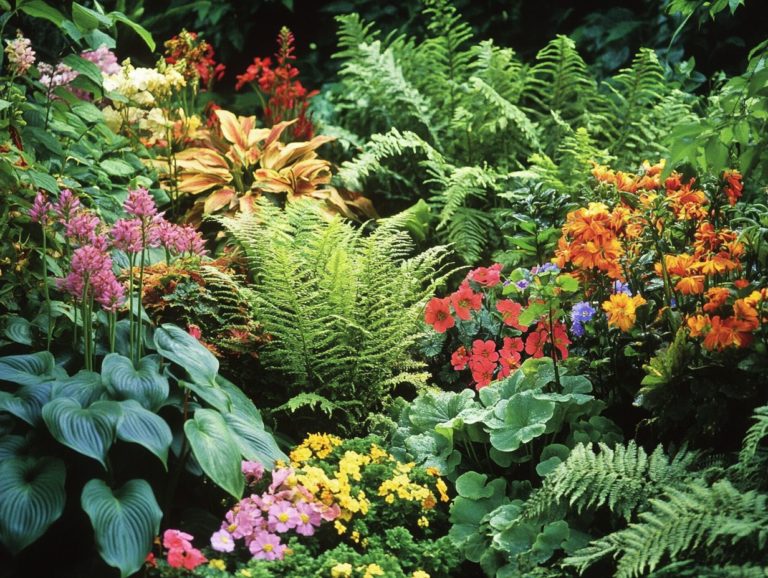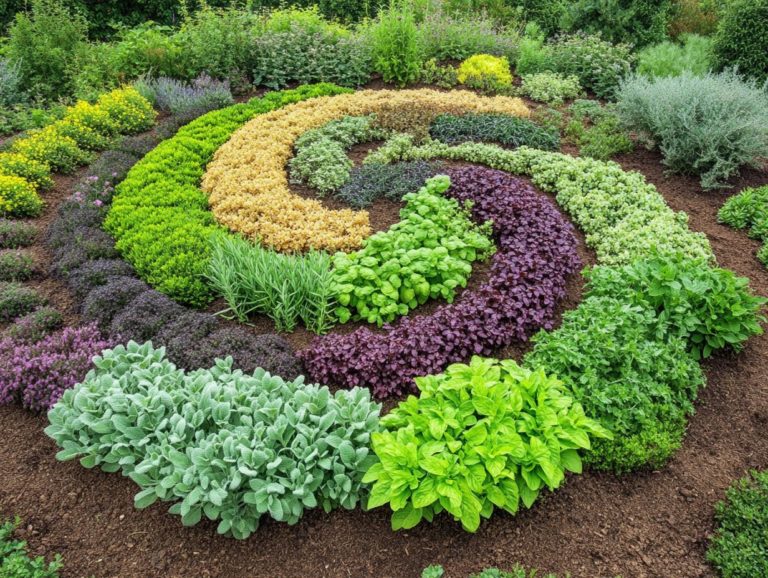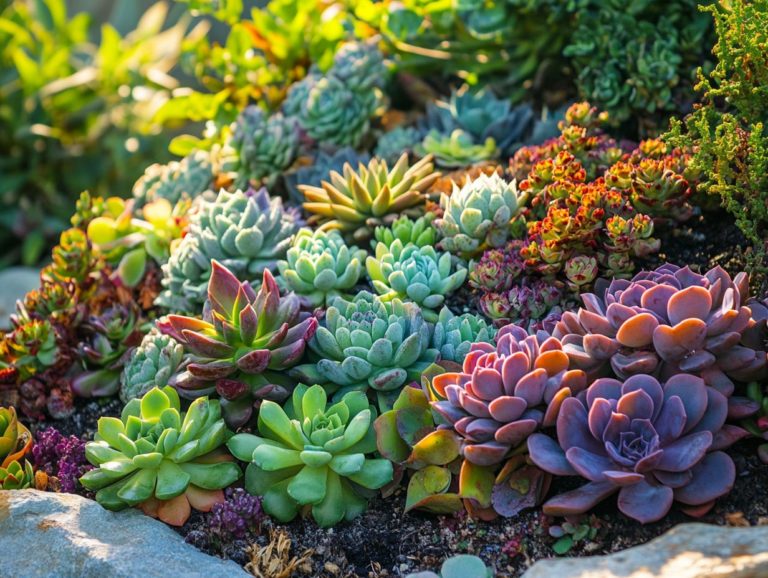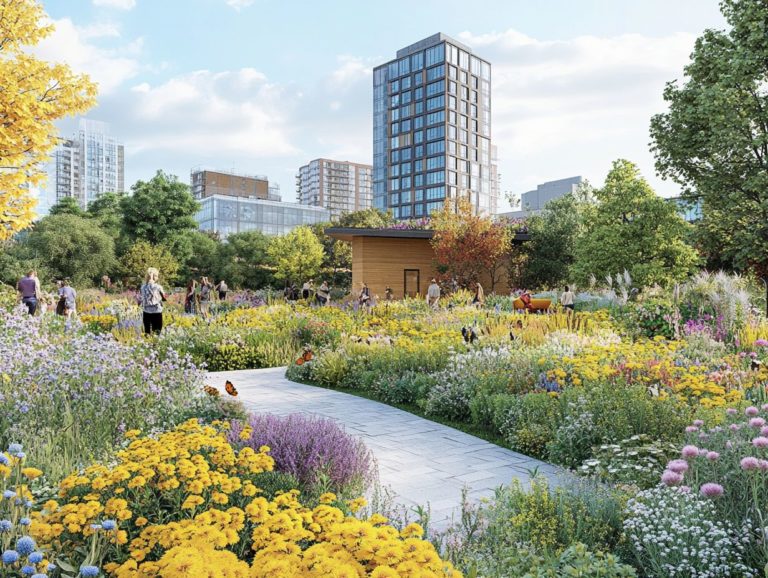“How to Select Plants for a Food Forest”
Food forests present a remarkable opportunity to cultivate sustainable, productive landscapes that beautifully mimic natural ecosystems.
In this article, you ll uncover what food forests are, the many benefits they provide for the environment and your health, and the essential considerations to keep in mind when selecting plants.
From grasping the nuances of climate and soil conditions to mastering the art of companion planting, you ll explore the diverse array of plants you can incorporate into your food forest.
We ll walk you through the planning and design process, empowering you to create your own edible paradise.
Join in on the journey to cultivate food forests that nourish both your body and the planet.
Contents
- Key Takeaways:
- Understanding Food Forests
- Benefits of Growing a Food Forest
- Factors to Consider When Selecting Plants
- Types of Plants to Include in a Food Forest
- How to Plan and Design a Food Forest
- Frequently Asked Questions
- What is a food forest and why should I consider selecting plants for one?
- How do I determine which plants are suitable for my food forest?
- What types of plants should I include in my food forest?
- Can I incorporate non-edible plants in my food forest?
- How do I maintain my food forest once the plants are selected and planted?
- Where can I find resources for selecting plants for a food forest?
Key Takeaways:
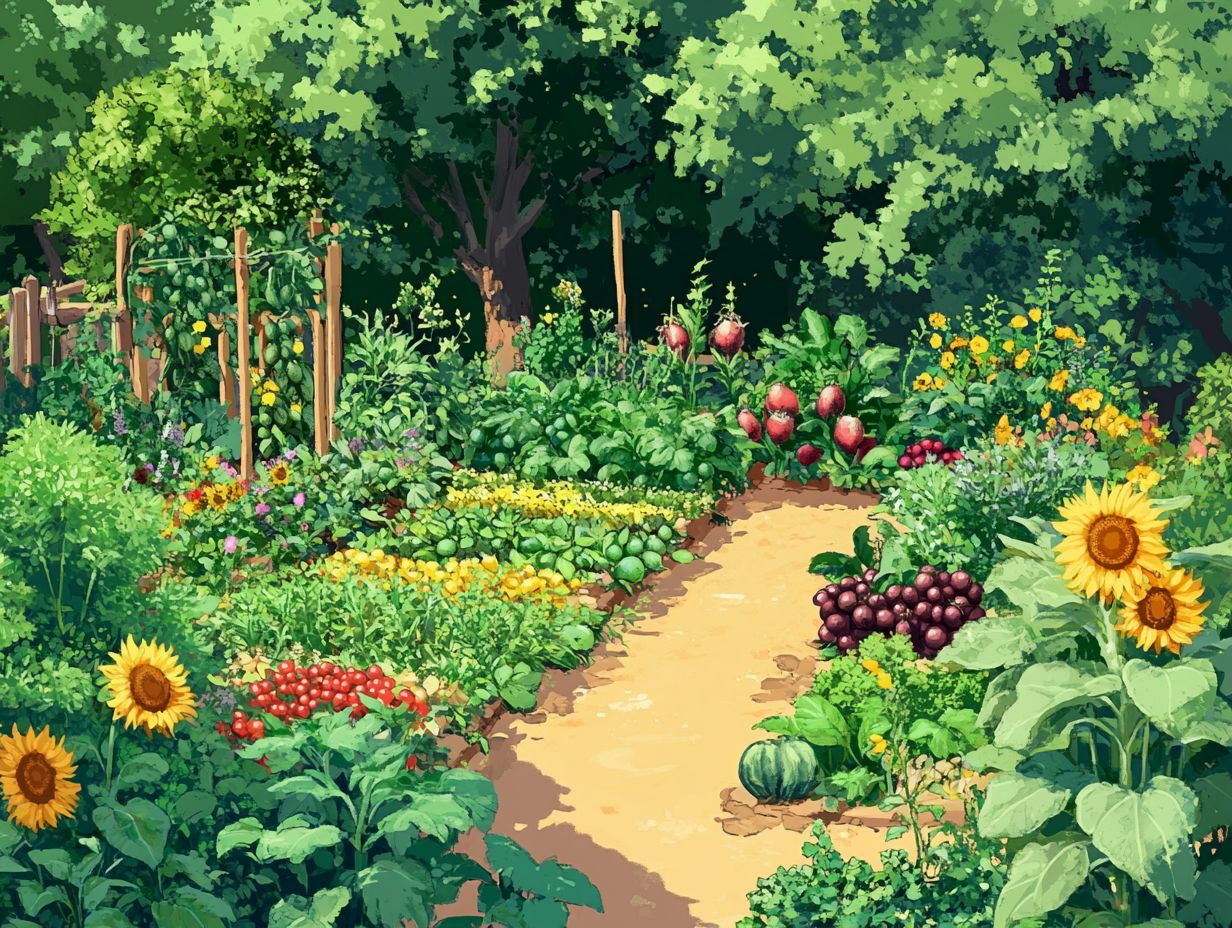
- Diversify plant selection to promote a healthy ecosystem in a food forest.
- Consider climate, soil, and companion planting when selecting plants.
- Include trees, shrubs, herbs, and vines for a thriving food forest.
Understanding Food Forests
Understanding food forests requires you to appreciate the seamless integration of diverse plant communities that provide not only edible yields but also vital ecological functions. These systems enhance soil fertility, promote biodiversity, and create habitats for wildlife.
They mimic natural ecosystems. This design ensures interactions among plant layers create a self-sufficient and productive landscape. By incorporating native species, food forests not only contribute to sustainable gardening practices but also nurture local ecosystems, all while supplying abundant resources for your community.
What is a Food Forest?
A food forest is a sustainable gardening approach that mirrors the structure and diversity of natural ecosystems, allowing you to cultivate a vibrant edible landscape through the thoughtful planting of various species.
This method typically features layers of vegetation, including tall trees, shrubs, herbaceous plants, and ground covers, all designed to maximize sunlight and space while minimizing the need for constant upkeep.
By embracing permaculture</b, which is a way of farming that works with nature, a food forest champions a balanced ecosystem, enabling you to integrate crops that support one another, such as nitrogen-fixing plants alongside fruit-bearing trees.
Take, for example, the addition of berry bushes; they not only yield a delightful harvest but also create essential wildlife habitats, attracting pollinators and beneficial insects to your garden.
By emulating native plant communities, food forests promote biodiversity and resilience, nurturing an environment where both ecosystems and people can flourish.
Benefits of Growing a Food Forest
Growing a food forest offers amazing benefits that you won’t want to miss! It includes significant environmental enhancements like improved biodiversity, elevated crop yields, and the cultivation of a healthier ecosystem. It stands as an essential practice for anyone committed to sustainable gardening.
Environmental and Health Benefits
The environmental benefits of a food forest are remarkable, offering enhanced biodiversity, improved soil health through nitrogen fixation, and the attraction of beneficial insects all of which contribute to a flourishing ecosystem.
This ecosystem serves as a sanctuary for local wildlife, including birds, pollinators, and small mammals, while significantly reducing your reliance on chemical fertilizers. It showcases the transformative power of organic gardening practices.
By promoting natural pest control and cultivating a diverse array of plant species, a food forest nurtures a balanced environment. This self-sustaining system invites you to engage with your surroundings, bolstering local food security and encouraging a healthier lifestyle.
Food forests also help store carbon and improve air quality. These ecological havens are essential allies in the fight against climate change, proving invaluable for both nature and humanity.
Ready to transform your space into a vibrant food forest? Let s get started!
Factors to Consider When Selecting Plants
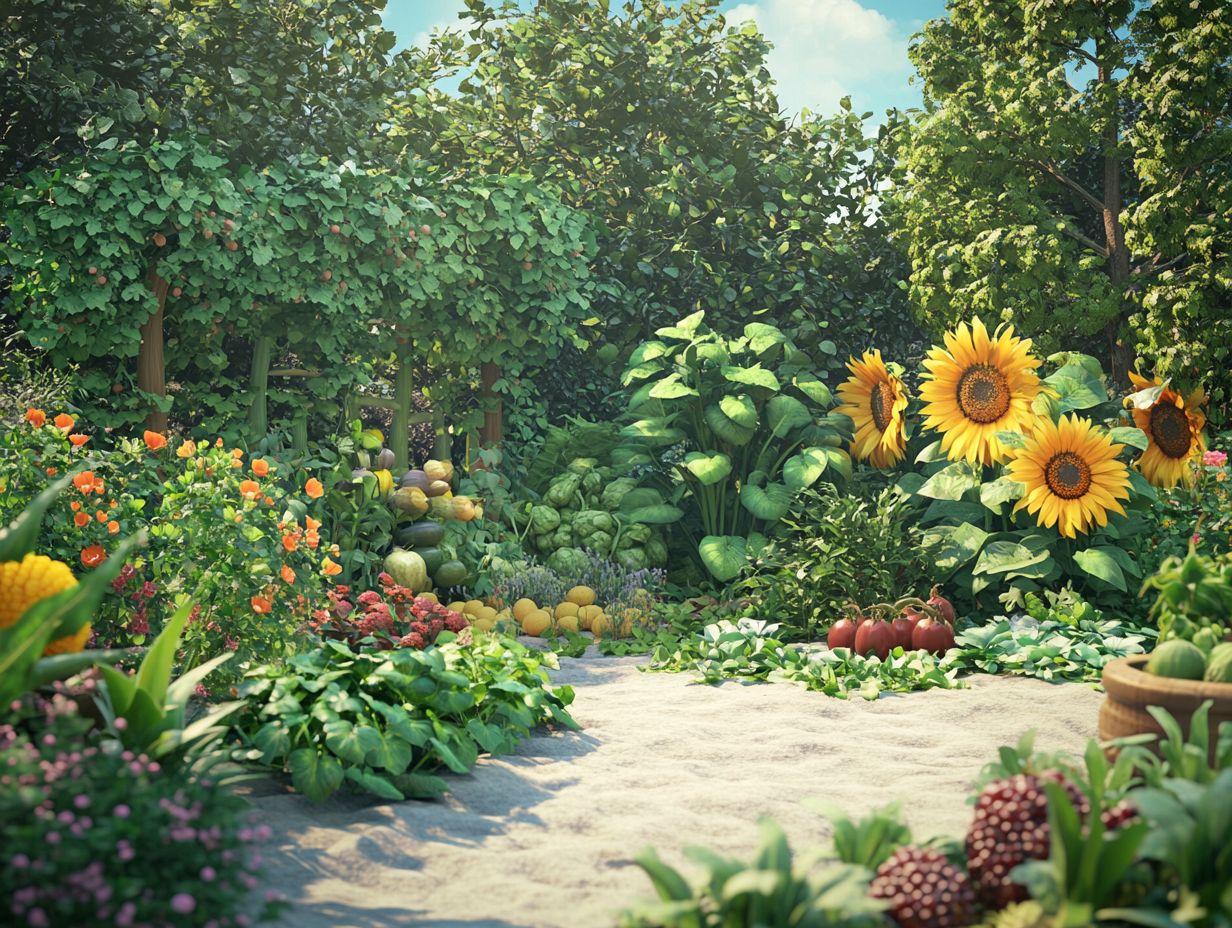
When selecting plants for your food forest, consider the climate and soil conditions.
This approach sets the foundation for a thriving ecosystem.
Climate and Soil Conditions
Understanding the climate and soil conditions is essential for establishing a successful food forest because these elements significantly impact your plant selection and overall growth potential.
The interaction between local climate patterns and soil health creates a foundation for a thriving ecosystem that supports diverse flora.
Use tools like climate mapping and local climate checks to assess sunlight exposure, wind patterns, and moisture levels.
Conducting soil tests provides vital insights, including pH levels, nutrient availability, and soil texture. All of these are crucial for determining the most suitable plant species for your forest.
Incorporating organic matter can really boost your soil quality! This helps your food forest flourish and stay strong against environmental changes.
Companion Planting
Companion planting in a food forest involves strategically pairing different species to enhance growth, improve soil fertility, and control pests, creating a symbiotic environment.
By fostering relationships between plants, you promote healthier ecosystems where beneficial insects thrive.
For instance, planting marigolds alongside tomatoes can deter nematodes. Meanwhile, basil not only enhances the flavors of nearby tomato plants but also helps repel harmful insects.
Consider pairing corn, beans, and squash known as the Three Sisters. This natural alliance optimizes space and resources: corn provides a structure for the beans to climb, the beans enhance nitrogen levels, and the squash serves as ground cover, effectively preventing weeds.
These thoughtful combinations not only bolster crop resilience but also cultivate a balanced habitat, minimizing the need for synthetic pesticides.
Types of Plants to Include in a Food Forest
In a food forest, a diverse array of plants is absolutely essential. Think edible trees, herbaceous perennials, and vining plants all working together to create a productive and sustainable ecosystem.
This carefully curated mix enhances biodiversity and cultivates a thriving environment for both you and nature.
Edible Trees and Shrubs
Edible trees and shrubs like the American Persimmon and Paw Paw are key to your food forest’s productivity!
These plants not only boost biodiversity but also yield nutritious fruits.
Take the American Persimmon, for example. Its sweet, flavorful fruits are packed with vitamins.
The Paw Paw boasts a creamy texture and unique taste, making it a fantastic source of fiber and antioxidants.
Asian pears are treasures, celebrated for their crisp texture and refreshing flavor, which makes them a staple in sustainable orchards.
The Mulberry tree adapts to various conditions and yields berries that benefit birds and pollinators, promoting ecological harmony.
By weaving these edible species into your food forest, you create a delightful tapestry of flavors and nurture a resilient, self-sustaining ecosystem.
Herbaceous Plants
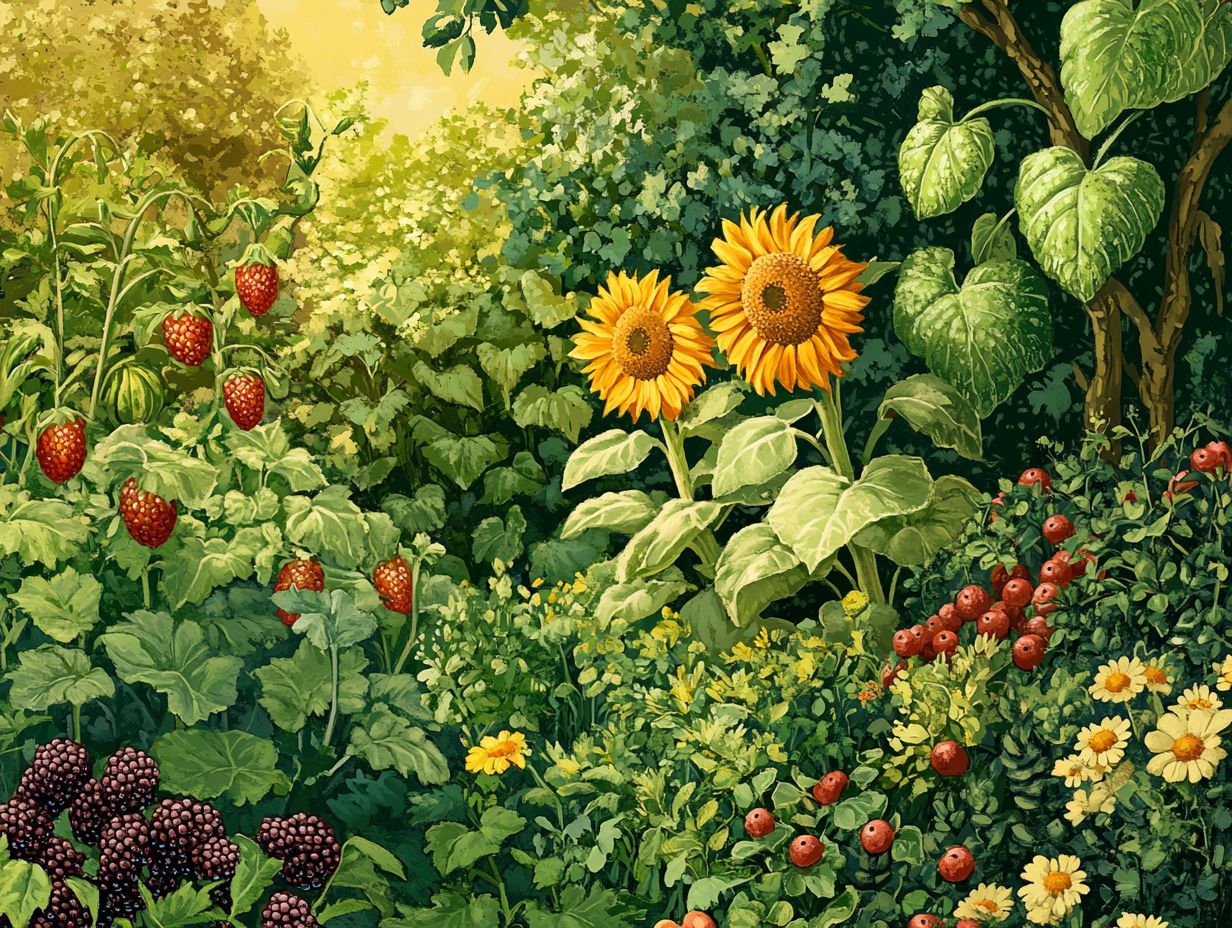
Herbaceous plants, especially herbaceous perennials and ground cover varieties, play a critical role in a food forest. They enhance soil health, support nitrogen fixation, and attract vital pollinators.
These plants lay the groundwork for biodiversity. They create habitats for beneficial insects while their extensive root systems work tirelessly to prevent soil erosion. By providing shade and retaining moisture, they help foster a microclimate a small area with a different climate than its surroundings that benefits the entire ecosystem. For example, plants like comfrey and yarrow enrich the soil with organic matter and double as green manure plants that improve soil health when they decompose.
This approach creates a thriving ecosystem where diverse species flourish. It significantly contributes to the resilience and productivity of the food forest. By thoughtfully integrating these herbaceous plants into your design, you’ll likely see noticeable improvements in both ecosystem vitality and crop yield.
Vining Plants
Vining plants are essential to creating a thriving food forest. They require robust support structures while adding to the beauty and utility of your edible landscape through their impressive vertical growth. By climbing, these plants make efficient use of space, allowing a diverse array of species to coexist harmoniously, even in limited areas.
When integrated thoughtfully, they enhance biodiversity and attract various beneficial insects and microorganisms that promote soil health. Pay attention to plant spacing to cultivate an environment where vining plants flourish without overly competing with their neighboring crops. Implement sturdy trellises or arbors to optimize vertical space and offer essential shelter and support.
Incorporating these remarkable plants into your landscape nurtures a lush, productive ecosystem that benefits both your edible yields and local wildlife.
How to Plan and Design a Food Forest
When planning and designing a food forest, it’s essential to embrace a strategic approach. This journey involves carefully observing your site, interpreting the landscape, and establishing a well-structured maintenance schedule to ensure optimal growth.
Each step contributes to creating a thriving ecosystem that nourishes and inspires.
Mapping Out the Space
Mapping out the space for your food forest is crucial. It enables you to thoughtfully arrange planting areas based on important factors like sun exposure and site analysis.
During this initial planning phase, assess the landscape s characteristics, including natural contours, existing vegetation, and access to water sources. Observing how sunlight interacts with your site at different times of the day is vital; this will help you identify areas of full sun, partial shade, and complete shade throughout the year.
Place taller species to the north of shorter plants to ensure light access. Consider wind patterns and soil type to select companion plants that can thrive together, ultimately contributing to a diverse and productive ecosystem.
Creating a Planting Schedule
Creating a planting schedule for your food forest is essential. It ensures that plants are introduced at just the right moment, considering growth conditions and optimal harvest frequency.
This strategic approach enhances the health of your ecosystem and maximizes yields throughout the growing season. By understanding the unique needs of each plant such as their preferred temperature and soil moisture you can align your efforts with nature’s rhythms.
Embracing seasonal planting strategies becomes paramount, allowing a rich diversity of crops to thrive together. By observing local climate patterns and soil conditions, you can effectively time your plant introductions, leading to bountiful harvests and a flourishing food forest.
Watch this video for tips on planting your food forest.
Frequently Asked Questions
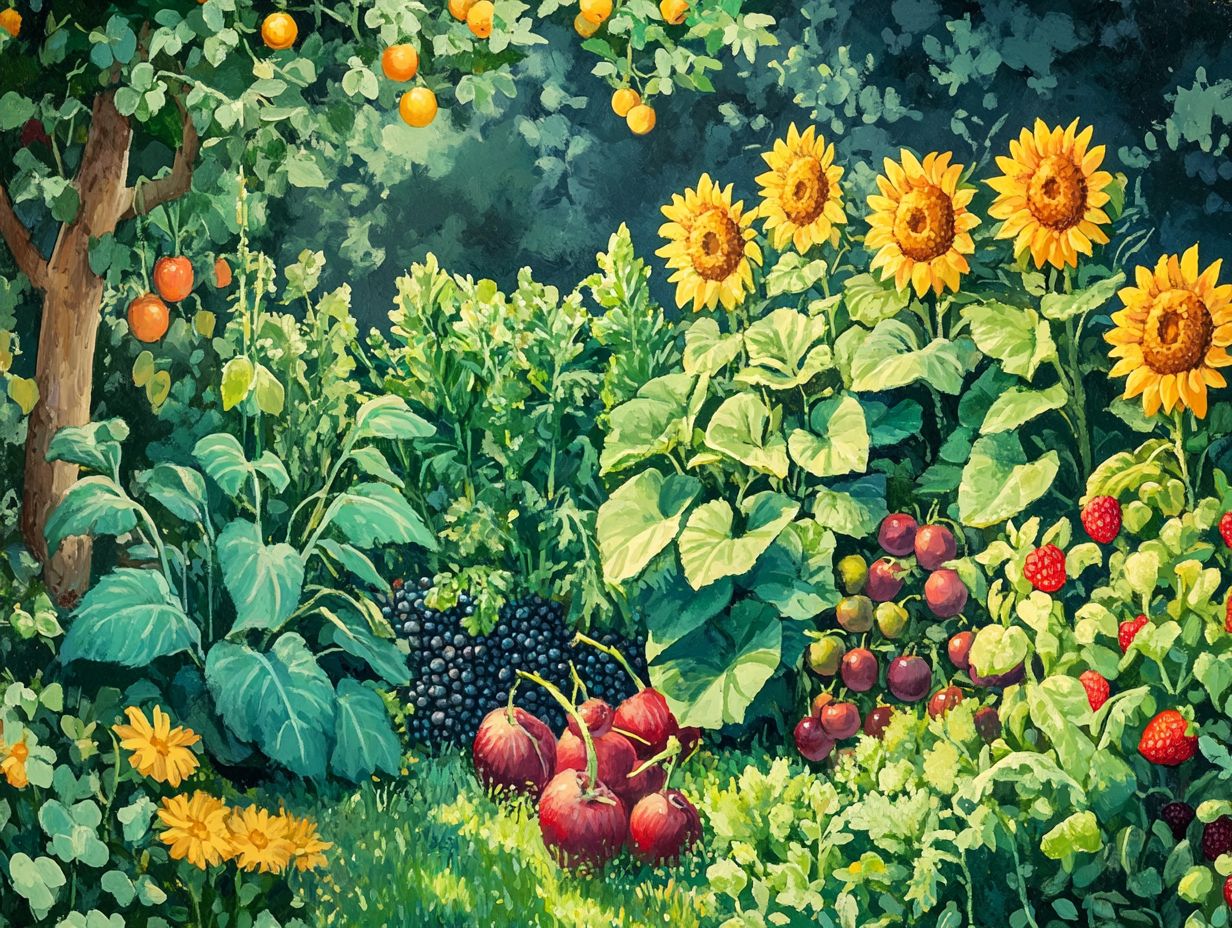
Have more questions? Feel free to reach out!
What is a food forest and why should I consider selecting plants for one?
A food forest is a self-sustaining agricultural system that mimics a natural forest. It creates an incredible environment that feeds you while promoting a variety of plants and animals.
Selecting the right plants can develop a low-maintenance food source for you and your community!
How do I determine which plants are suitable for my food forest?
When selecting plants, consider your climate and soil type. Choose plants that are native or well-adapted to your region.
Make sure they will thrive in your soil. You should also assess each plant’s growth habits and space requirements to prevent competition with others.
What types of plants should I include in my food forest?
A food forest should include a variety of plants such as fruit and nut trees, shrubs, herbs, vegetables, and ground cover. Selecting plants that provide a balanced diet is essential.
Support pollinators and beneficial insects by including plants that attract them. Incorporating nitrogen-fixing plants helps improve soil health and boosts productivity!
Can I incorporate non-edible plants in my food forest?
Yes, non-edible plants are valuable in a food forest as they provide habitat for beneficial insects and attract pollinators. Choose non-invasive plants that won’t compete with your edible plants.
How do I maintain my food forest once the plants are selected and planted?
A food forest requires minimal maintenance once established, but regular upkeep is necessary. This includes pruning, weeding, and mulching to promote plant health.
Monitor for pests and diseases to address them promptly. Regular observation ensures the long-term success of your food forest!
Where can I find resources for selecting plants for a food forest?
Many resources are available for selecting plants, including books, online guides, and workshops. Consulting local gardening experts or visiting nearby food forests can provide valuable insights.
Joining a community gardening group or attending a permaculture course offers knowledge and support for creating a successful food forest.

